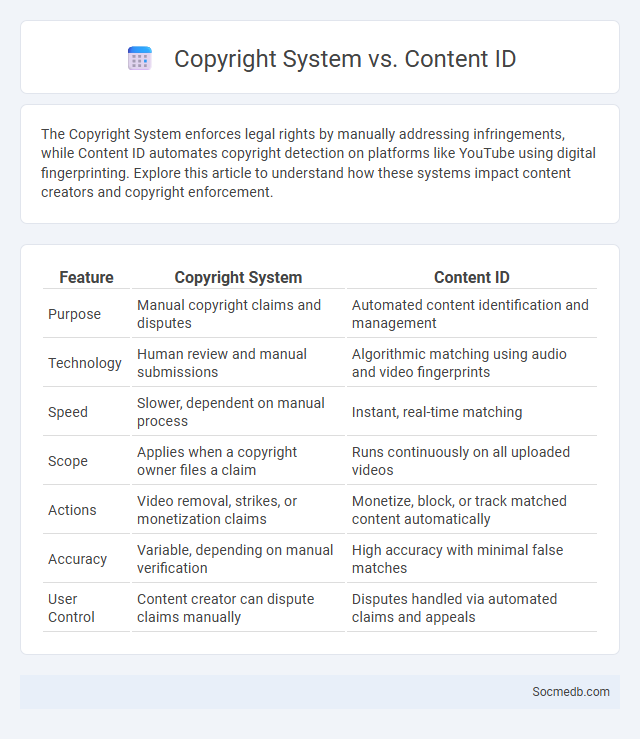
Photo illustration: Copyright System vs Content ID
The Copyright System enforces legal rights by manually addressing infringements, while Content ID automates copyright detection on platforms like YouTube using digital fingerprinting. Explore this article to understand how these systems impact content creators and copyright enforcement.
Table of Comparison
| Feature | Copyright System | Content ID |
|---|---|---|
| Purpose | Manual copyright claims and disputes | Automated content identification and management |
| Technology | Human review and manual submissions | Algorithmic matching using audio and video fingerprints |
| Speed | Slower, dependent on manual process | Instant, real-time matching |
| Scope | Applies when a copyright owner files a claim | Runs continuously on all uploaded videos |
| Actions | Video removal, strikes, or monetization claims | Monetize, block, or track matched content automatically |
| Accuracy | Variable, depending on manual verification | High accuracy with minimal false matches |
| User Control | Content creator can dispute claims manually | Disputes handled via automated claims and appeals |
Introduction to Copyright Systems in Digital Media
Copyright systems in digital media establish legal protections for original content shared on social media platforms, safeguarding creators' rights to control distribution and reproduction. These systems rely on technological tools such as digital watermarks, content recognition algorithms, and automated takedown procedures to address copyright infringement rapidly. Understanding platform-specific policies and international copyright laws is essential for content creators and users to navigate digital rights effectively.
Understanding Copyright Protection Online
Copyright protection online is crucial for safeguarding original content on social media platforms such as Instagram, YouTube, and TikTok, where millions of users share images, videos, and music daily. Understanding the Digital Millennium Copyright Act (DMCA) and its takedown procedures helps content creators prevent unauthorized use and address infringement effectively. Strong knowledge of fair use, licensing agreements, and platform-specific policies enhances enforcement of intellectual property rights in the digital environment.
What is Content ID?
Content ID is a digital fingerprinting system developed by YouTube that automatically identifies and manages copyrighted material uploaded to the platform. It enables copyright owners to claim, monetize, or block content containing their protected works, ensuring proper rights enforcement. By using Content ID, you can protect your intellectual property and generate revenue through licensed use.
How Does Content ID Work?
Content ID is a powerful digital fingerprinting system used by platforms like YouTube to identify copyrighted material in videos. When you upload content, the system scans it against a vast database of registered audio and video files to detect matches. If your video contains copyrighted material, rights holders can choose to block, monetize, or track your content through automated claims.
Copyright Strike: Definition and Consequences
A copyright strike on social media occurs when content you upload infringes on another creator's intellectual property rights, leading to potential removal of your material. Platforms like YouTube and Instagram enforce these strikes to protect original content, often resulting in account restrictions or suspension after multiple violations. Understanding copyright laws helps you avoid strikes and maintain your social media presence securely.
Key Differences: Content ID vs. Copyright Strike
Content ID is an automated system used by platforms like YouTube to identify and manage copyrighted material by allowing rights holders to monetize, track, or block their content. A copyright strike occurs when a rights holder formally submits a takedown request, resulting in the removal of the infringing content and potential penalties for the uploader. While Content ID offers a proactive and monetization-focused approach, copyright strikes enforce stricter consequences, including account suspension or termination.
Rights Holder Options: Manual Takedowns vs. Content ID Claims
Rights holders navigate social media platforms by choosing between manual takedowns and automated Content ID claims to protect intellectual property. Manual takedowns require submitting specific infringement reports, resulting in the immediate removal of unauthorized content, while Content ID systems automatically detect and monetize or block copyrighted material. Balancing these options helps rights holders efficiently control their content distribution and revenue across platforms like YouTube, Facebook, and Instagram.
Common Misconceptions About Copyright Enforcement
Common misconceptions about copyright enforcement on social media include the belief that all reposted content is automatically legal or that fair use always permits sharing without permission. Many users underestimate the platform's responsibility to remove infringing content promptly under the Digital Millennium Copyright Act (DMCA). Understanding the nuances of copyright laws and platform-specific policies is crucial for both content creators and users to avoid potential legal issues and protect intellectual property rights.
Navigating Disputes and Appeals in the Copyright System
Navigating disputes and appeals in the copyright system on social media platforms requires understanding the Digital Millennium Copyright Act (DMCA) takedown process and the counter-notification procedures. Content creators can file counterclaims to restore removed posts when they believe their work was wrongly targeted, while platform policies often provide mechanisms for escalating unresolved issues. Awareness of the appeals framework improves fair use protections and helps maintain compliance with copyright laws across major platforms like YouTube, Facebook, and Instagram.
Best Practices for Content Creators to Avoid Copyright Issues
Content creators must ensure their work adheres to copyright laws by using original content or properly licensed materials from reputable sources like Creative Commons or stock libraries. Always provide accurate attribution when required and avoid using copyrighted music, images, or videos without permission to prevent takedown notices or legal consequences. You can protect your social media presence by regularly reviewing platform guidelines and employing copyright monitoring tools to detect potential infringements early.
 socmedb.com
socmedb.com